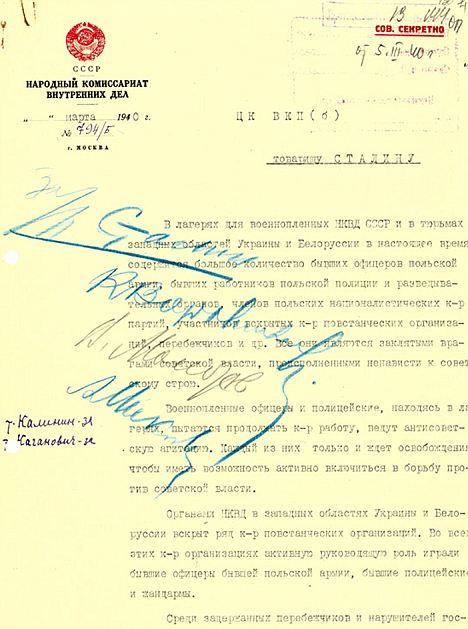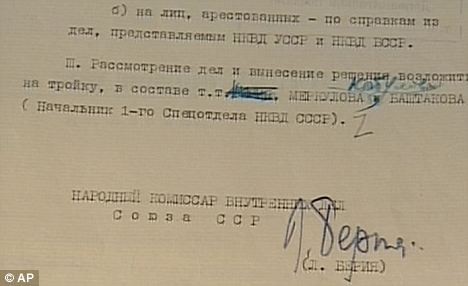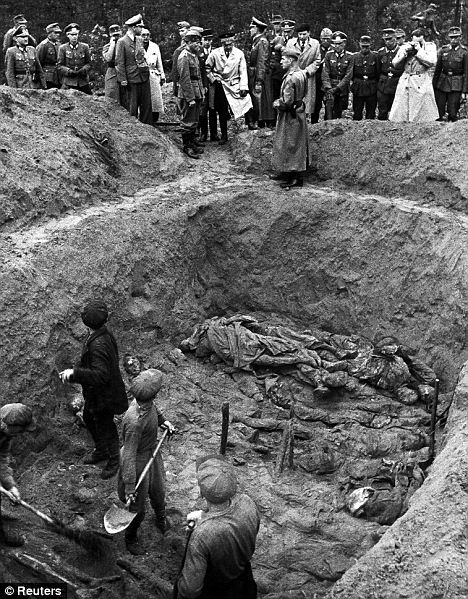Russia made public for the first time documents proving Soviet NKVD secret police massacred 22,000 Polish officers, intellectuals and other prominent citizens in World War II.
President Dmitry Medvedev released the material in the latest of a flurry of gestures of solidarity with Warsaw since Polish President Lech Kaczynski, his wife and 94 officials were killed in a plane crash en route to a ceremony commemorating the Katyn massacre.
The move also reflects a new willingness by Moscow to accept responsibility for one of the most shameful episodes of the bloody Stalin era.
This is one of the documents released . Dated 1940 it bears the signature of Stalin (in blue) at the top of the letter.
This document bears the signature of head of the feared Soviet NKVD secret police Lavrenty Beria. Nine months after Stalin’s death in 1953 he was arrested, tried and shot
Yet while the move was welcomed in Poland, it is also clear that Moscow is refusing to publish other top secret documents related to Katyn – including the names of those who shot the Poles in 1940 in what is known as the ‘forest of death’.
And there remains resistance in Russia to accepting that the atrocity amounted to genocide, or that those killed were victims of political repression.
Scanned photos of several documents, including a March 5, 1940, note from NKVD head Lavrenty Beria – signed by Stalin and three other members of the Soviet Politburo – were published online. The documents ordered the execution of Polish ‘nationalists and counter-revolutionaries’.
Medvedev described the publication as a ‘duty’.
The mass graves were found by the German army when it invaded Russia. It was immediately used as propaganda against the Russians who continued to deny they were to blame until 1990. But even today the Communist Party in Russia says the killings were carried out by German soldiers
‘Let people see it, let them know who made the decision to kill the Polish officers,’ said Medvedev. ‘It’s all there in the documents. All signatures are there, all the faces are known.’
Katyn is an enduring symbol for Poles of their suffering at Soviet hands in the 20th century. For decades, Moscow blamed the Nazis for the massacre and only acknowledged its responsibility in 1990, a year after the fall of communism in Poland.
The archives show the complicity of Soviet dictator Josef Stalin in the darkest moment of modern Polish history which wiped out a generation of the country’s highest and most able people.
One is a ‘top secret’ letter dated March 1940 from the head of the Soviet secret police, the feared Lavrenty Beria, recommending the execution of Polish prisoners of war.
It is countersigned by Josef Stalin along with three other members of the Politburo, and calls for ‘the use of the highest means of punishment – death by shooting’.
Another document is a note from the head of the KGB in 1959 informing then Kremlin leader Nikita Khrushchev that important Katyn files had been destroyed.
The published documents and their contents have been known to historians, politicians and families of those killed since the early 1990s but this is the first time most Russians have been able to see the scanned originals.
However a number of documents dating from a 1990s Russian probe into Katyn, which include the names of those who committed the mass executions, remain classified.
Yan Rachinsky, of Russian human rights group Memorial, said the disclosure of the files online ‘is important but mainly symbolic’.
He stressed: ‘It does not settle the problem. There are still classified files from the Katyn investigation.’
Memorial is engaged in a legal battle to force disclosure of remaining secret documents.
Polish historian Andrzej Kunert said: ‘We can surely call the decision a breakthrough, because it seems that for the first time a website that is generally accessible to everyone in the Russian Federation publishes three very important documents concerning the Katyn massacre.
‘It is certainly a very important step forward.’
The Poles killed at Katyn and several other sites were taken prisoner by the Red Army in September 1939 when their country was divided up under a secret pact between Stalin and Adolf Hitler.
Russian archive chief Andrei Artyzov said the publication showed the Kremlin was showing ‘absolute openness in telling what happened in Katyn.
‘All the basic documents about these events have been published.’
The publication is also a further sign that long-running tensions between Russia and Poland are easing. Medvedev braved the closure of European airspace caused by a volcanic ash cloud on April 18 to attend Kaczynski’s funeral in Krakow and to tell Poles he hoped the tragedy could bring the two nations closer.
Last week, Russia’s Supreme Court ordered the Moscow City Court to consider Memorial’s appeal seeking declassification of a 2004 decision by military prosecutors to drop an investigation into the Katyn massacre.
There are 183 volumes of documents relating to the 1990-2004 investigation, and 116 of them are still closed.
However Russia’s opposition Communist Party still rejects the documents as false and insists the murder was committed by the Nazis.
Last week, the party issued a letter to Medvedev asking for a new investigation.
‘We’re forced to state that the Polish anti-Russian mourning ceremonies at Katyn, supported by (Prime Minister Vladimir) Putin, seem insulting to many citizens of our country, first of all to many World War Two veterans,’ the letter said.



